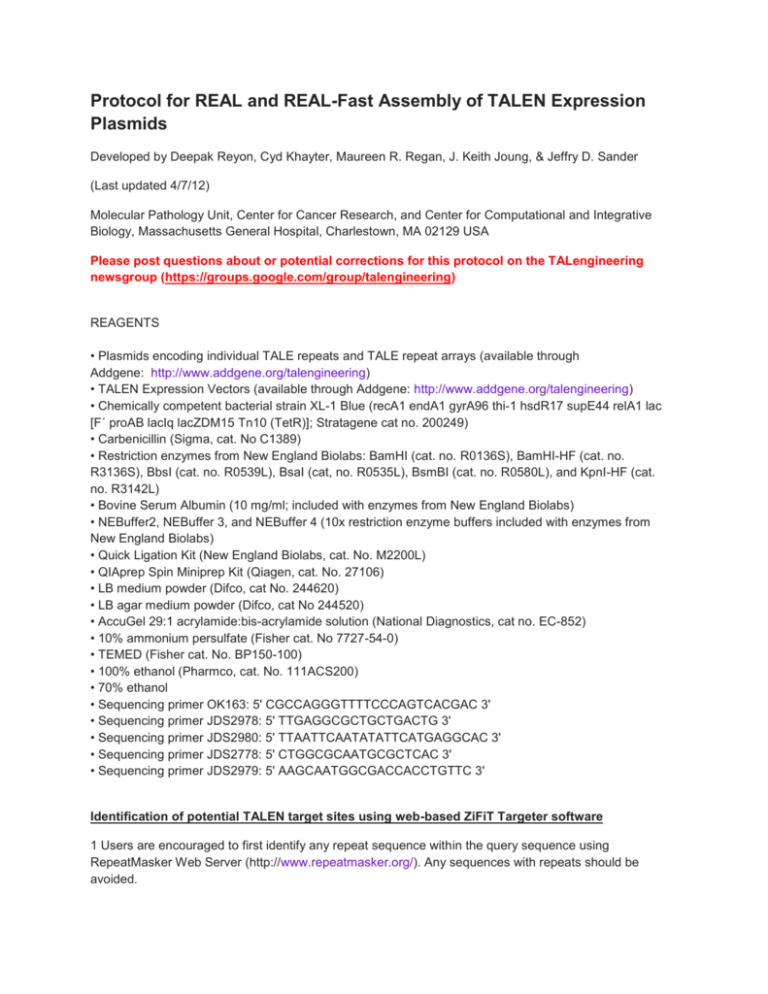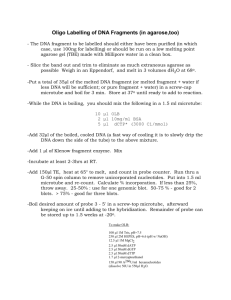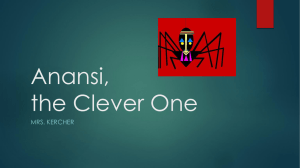Protocol for REAL and REAL-Fast Assembly of TALEN Expression
advertisement

Protocol for REAL and REAL-Fast Assembly of TALEN Expression Plasmids Developed by Deepak Reyon, Cyd Khayter, Maureen R. Regan, J. Keith Joung, & Jeffry D. Sander (Last updated 4/7/12) Molecular Pathology Unit, Center for Cancer Research, and Center for Computational and Integrative Biology, Massachusetts General Hospital, Charlestown, MA 02129 USA Please post questions about or potential corrections for this protocol on the TALengineering newsgroup (https://groups.google.com/group/talengineering) REAGENTS • Plasmids encoding individual TALE repeats and TALE repeat arrays (available through Addgene: http://www.addgene.org/talengineering) • TALEN Expression Vectors (available through Addgene: http://www.addgene.org/talengineering) • Chemically competent bacterial strain XL-1 Blue (recA1 endA1 gyrA96 thi-1 hsdR17 supE44 relA1 lac [F´ proAB lacIq lacZDM15 Tn10 (TetR)]; Stratagene cat no. 200249) • Carbenicillin (Sigma, cat. No C1389) • Restriction enzymes from New England Biolabs: BamHI (cat. no. R0136S), BamHI-HF (cat. no. R3136S), BbsI (cat. no. R0539L), BsaI (cat, no. R0535L), BsmBI (cat. no. R0580L), and KpnI-HF (cat. no. R3142L) • Bovine Serum Albumin (10 mg/ml; included with enzymes from New England Biolabs) • NEBuffer2, NEBuffer 3, and NEBuffer 4 (10x restriction enzyme buffers included with enzymes from New England Biolabs) • Quick Ligation Kit (New England Biolabs, cat. No. M2200L) • QIAprep Spin Miniprep Kit (Qiagen, cat. No. 27106) • LB medium powder (Difco, cat No. 244620) • LB agar medium powder (Difco, cat No 244520) • AccuGel 29:1 acrylamide:bis-acrylamide solution (National Diagnostics, cat no. EC-852) • 10% ammonium persulfate (Fisher cat. No 7727-54-0) • TEMED (Fisher cat. No. BP150-100) • 100% ethanol (Pharmco, cat. No. 111ACS200) • 70% ethanol • Sequencing primer OK163: 5' CGCCAGGGTTTTCCCAGTCACGAC 3' • Sequencing primer JDS2978: 5' TTGAGGCGCTGCTGACTG 3' • Sequencing primer JDS2980: 5' TTAATTCAATATATTCATGAGGCAC 3' • Sequencing primer JDS2778: 5' CTGGCGCAATGCGCTCAC 3' • Sequencing primer JDS2979: 5' AAGCAATGGCGACCACCTGTTC 3' Identification of potential TALEN target sites using web-based ZiFiT Targeter software 1 Users are encouraged to first identify any repeat sequence within the query sequence using RepeatMasker Web Server (http://www.repeatmasker.org/). Any sequences with repeats should be avoided. 2| Visit the ZiFiT Targeter website at http://zifit.partners.org. 3| Click on the ZiFiT option on the top menu followed by the “Design TALE Nucleases” option under the “TALE Assembly” menu. 4| Paste the query sequence into the text box labeled ‘Sequence’. The sequences may be entered as raw data or in FASTA format. If multiple queries are entered they need to be in FASTA format. All numbers and characters that are not G, A, T, or C will be ignored. The user must indicate the nucleotide position at which they wish the break to occur by framing it with brackets (e.g.--[A] or [G]). ZiFiT Targeter will attempt to identify sites such that this nucleotide falls within the spacer sequence between the TALEN binding half- sites. 5| Check the option “Ignore redundant sites” to ensure that the sites identified differ from each other by at least 3 nucleotides (6 total) 6| By default, ZiFiT Targeter will only return the five highest- ranked sites it identifies using criteria described in Supplementary Discussion of Sander et al. http://www.nature.com/nbt/journal/v29/n8/full/nbt.1934.html). Users can display all the potential target sites identified by the program by checking the box for “Display all”. With this option checked, ZiFiT Targeter will return all potential TALEN target sites that consist of half-sites of lengths 12-22 base pairs and spacer sequences of lengths 12-23 base pairs. This option is not available while ZiFiT Targeter is operating in batch mode. 7| Click the Submit button. The output reports the top five TALEN target sites below the sequence entry box. If multiple queries are submitted the potential target sites for each query sequence is reported in a different tab. The position where the break is intended to occur is now demarcated with an asterisk. 8| To obtain a customized graphical guide for assembling a particular TALEN, click on the target site. ZiFiT generates graphical guides for assembling TALENs using either REAL or REAL-Fast by default. Users can access either guide by clicking on the appropriate buttons at the top of the page. Construction of TAL Arrays 9| Using the graphical output generated by ZiFiT Targeter as a guide, perform the series of ligations indicated in the first row of the REAL or REAL-Fast figure by repeating steps 10 - 19 below for each ligation. The numbers above each TALE repeat unit or array in the graphical guide identify the names of the plasmids that are to be used for each ligation. For each pair to be ligated, the TALE repeat on the left is the amino-terminal repeat and the one on the right is the carboxy- terminal repeat. For each ligation, a DNA vector backbone encoding the amino-terminal repeat(s) is ligated to a fragment encoding the carboxy- terminal repeat(s). 10| Digest plasmid(s) encoding the amino-terminal TALE repeat(s) with BamHI and BsaI using the following conditions: Plasmid encoding amino-terminal TALE repeat 1.5 µg 10X Buffer (NEBuffer 4) 4 µl Bovine Serum Albumin (10mg/ml) 4 µl BsaI (5 U/µl) 2 µl BamHI (20 U/µl) 2 µl Add nuclease-free water to a total volume of 40 µl Incubate the reaction at 37°C for 2 hours 11| Isolate the vector backbone from the restriction digest of step 10 on a 5% non-denaturing polyacrylamide gel and purify the DNA according to the protocol found in Box 2 of Maeder et al., Nat Protocols 2009. Resuspend the final DNA pellet in 20 µl of nuclease-free water. 12| Digest plasmid(s) encoding the carboxy-terminal TALE repeat(s) with BbsI and BamHI using the following conditions: Plasmid encoding carboxy-terminal TALE repeat(s) 1.5 µg NEB Buffer 2 4 µl Bovine Serum Albumin (10mg/ml) 4 µl BbsI (5 U/µl) 2 µl BamHI (20 U/µl) 2 µl Add nuclease-free water to a total volume of 40 µl Incubate the reaction at 37°C for 2 hours 13| Isolate the DNA fragment encoding the TALE repeat(s) from the restriction digest of step 12 on a 5% non-denaturing polyacrylamide gel and purify the DNA using the protocol found in Box 2 of Maeder et al., Nat Protocols 2009. Resuspended the final DNA pellet in 20 µl of nuclease- free water. Note that the size of the DNA fragment will be equal to N x ~102 bps where N is the number of TALE repeats encoded on the fragment. 14| Ligate the purified DNA fragment isolated in step 13 into the purified vector backbone isolated in step 11 as follows: Purified vector backbone (from step 11) 1 µl Purified fragment (from step 13) or water 3 µl Quick Ligase Buffer (NEB) 4.5 µl T4 DNA Ligase (400U/ul) 0.5 µl Total 9 µl Incubate this reaction at room temperature for 15 minutes. Also perform a control ligation using vector backbone alone (i.e.--without fragment). 15| Transform each ligation from step 14 into 90 µl chemically competent XL1-Blue cells as follows: Mix the ligations with competent cells and incubate on ice for 5 minutes. Perform heat shock at 42°C for 1 minute and return the transformations to ice for 1 minute. Add 500 µl LB to the cells and recover with agitation for 45 minutes at 37°C. Plate 200 µl of each transformation on an LB plate supplemented with 100 µg ml-1 carbenicillin. Grow the transformed cells at 37°C for 12 – 14 hours. 16| Ensure that the actual ligation/transformation of step 15 yields at least 10-fold more colonies than the control ligation (backbone only) and then inoculate two single colonies from the actual ligation/transformation plate into 4 ml of LB supplemented with carbenicillin 100 mg ml–1. Allow these cells to grow overnight at 37°C with agitation. CRITICAL STEP: To reduce the risk of plasmid deletions, do not allow the cultures to grow for more than 14 hours. 17| Use a QIAprep spin Miniprep kit to isolate plasmid DNA from these overnight cultures. 18| Digest candidate plasmids with XbaI and BamHI to determine whether they have successfully taken up the fragment encoding the carboxy-terminal TALE repeat(s) as follows: Plasmid 1 µg 10X Buffer (NEB Buffer 4) 4 µl Bovine Serum Albumin (10mg/ml) 4 µl XbaI (20 U/µl) 1 µl BamHI-HF (20 U/µl) 1 µl Add nuclease-free water to a total volume of 40 µl Incubate at 37°C for an hour. 19| Visualize the DNA fragments generated by the restriction digests from step 18 on a 5% nondenaturing polyacrylamide gel. Plasmids that have successfully taken up the fragment encoding the carboxy-terminal TALE repeat(s) should yield a ([(M + N) x 102] + 33) bp fragment (where M and N are the numbers of TALE repeats encoded by the vector backbone and fragment, respectively.) 20| Following completion of the first set of ligations, perform the series of ligations indicated in the second row of the graphical guide by using steps 10 - 19 above. 21| Continue performing ligations in subsequent rows of the graphical guide using steps 10 - 19 above until the final assembled array is completed. Cloning TAL arrays into the nuclease backbone 22| Digest the specific TALEN expression vector indicated at the bottom of the graphical output (pJDS70, pJDS71, pJDS74 or pJDS78; available from Addgene) with BsmBI restriction enzyme as follows. TALEN Expression Vector 2µg 10x Buffer (NEB Buffer #3) 5 µl BsmBI (10U/ul) 5 µl Add nuclease-free water to a total volume of 50 µl Incubate at 55°C for 3 hours 23| Isolate the vector backbone on a 5% non-denaturing polyacrylamide gel and purify the DNA using the protocol found in Box 2 of Maeder et al., Nat Protocols 2009. Resuspend the final pellet in 20 µl of nuclease-free water. 24| Digest plasmid(s) encoding the final assembled TALE repeat array (from step 21 above) with BbsI and BsaI as follows: Plasmid encoding assembled TALE repeat array 1.5 µg 10X Buffer (NEB Buffer 2) 4 µl Bovine Serum Albumin (10mg/ml) 4 µl BbsI (5 U/µl) 2 µl BsaI (10 U/µl) 2 µl Add nuclease-free water to a total volume of 40 µl Incubate at 37°C for 2 hours. 25| Isolate the DNA fragment encoding the TALE repeat array(s) from the restriction digest of step 24 on a 5% non-denaturing polyacrylamide gel and purify the DNA using the protocol found in Box 2 of Maeder et al., Nat Protocols 2009. Resuspend the final DNA pellet in 20 µl of nuclease-free water. Note that the size of the DNA fragment will be equal to N x ~102 bps where N is the number of TALE repeats encoded on the fragment. 26| Ligate the purified DNA fragment isolated in step 25 into the purified TALEN expression vector backbone isolated in step 23 as follows: Purified vector backbone (from step 23) 1 µl Purified fragment (from step 25) or water 3 µl Quick Ligase Buffer (NEB) 4.5 µl T4 DNA Ligase (400U/ul) 0.5 µl Total 9 µl Incubate at room temperature for 15 minutes. Also perform a vector backbone only ligation as a control. 27| Transform each ligation from step 26 into 90 µl chemically competent XL1-Blue cells as follows: Mix the ligations with competent cells and incubate on ice for 5 minutes. Perform heat shock at 42°C for 1 minute and return the transformations to ice for 1 minute. Add 500 µl LB to the cells and recover with agitation for 45 minutes at 37°C. Plate 200 µl of each transformation on an LB plate supplemented with 100 µg ml-1 carbenicillin. Grow the transformed cells at 37°C for 12 – 14 hours. 28| Ensure that the actual ligation/transformation of step 15 yields at least 10-fold more colonies than the control ligation (backbone only) and then inoculate two single colonies from the actual ligation/transformation plate into 4 ml of LB supplemented with carbenicillin 100 mg ml–1. Allow these cells to grow overnight at 37°C with agitation. CRITICAL STEP: To reduce the risk of plasmid deletions, do not allow the overnight bacterial cultures to grow for more than 14 hours. 29| Use a QIAprep spin Miniprep kit to isolate plasmid DNA from these overnight cultures. 30| Digest the candidate plasmids with KpnI-HF and BamHI-HF to determine whether they have successfully taken up the fragment encoding the carboxy-terminal TALE repeat(s) as follows: Plasmid 0.5 µg 10X Buffer (NEBuffer 4) 5 µl Bovine Serum Albumin (10 mg/ml) 5 µl KpnI-HF (20 U/µl) 1 µl BamHI-HF (20 U/µl) 1 µl Add nuclease-free water to a total volume of 50 µl Incubate for 2 hours at 37 °C 31| Visualize the fragment generated by the restriction digests from step 30 on a 5% non-denaturing polyacrylamide gel. Plasmids that have successfully taken up the fragment encoding the TALE repeat array should yield a (650 + [N x ~102]) bp fragment (where N is the number of TALE repeats encoded in the array.) 32| Optional: TALEN expression plasmids can be sequence-verified by DNA sequencing using forward primer JDS2978 and reverse primer JDS2980. 33. The nucleotide sequence of the final product is provided at the bottom of the graphical guide generated by ZiFiT Targeter.








